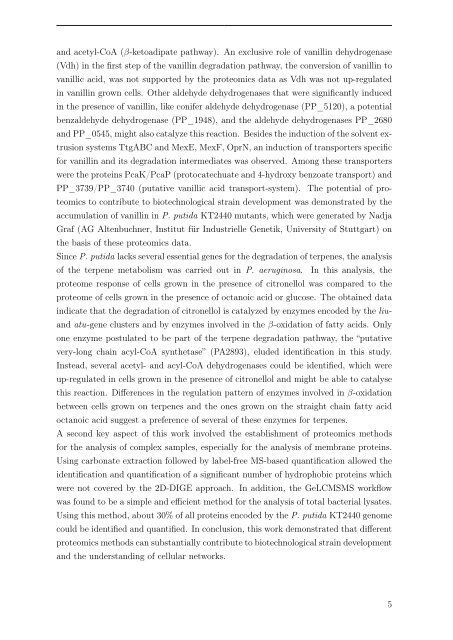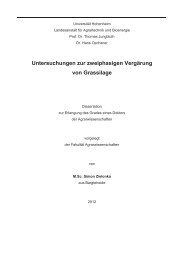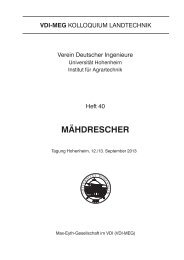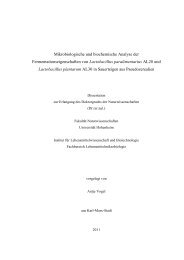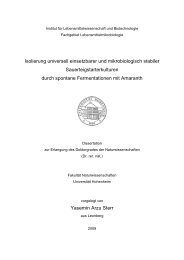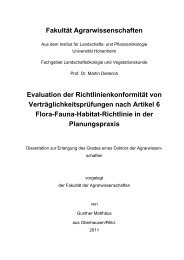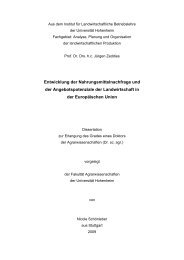Dokument 2.pdf - OPUS-Datenbank - Universität Hohenheim
Dokument 2.pdf - OPUS-Datenbank - Universität Hohenheim
Dokument 2.pdf - OPUS-Datenbank - Universität Hohenheim
Erfolgreiche ePaper selbst erstellen
Machen Sie aus Ihren PDF Publikationen ein blätterbares Flipbook mit unserer einzigartigen Google optimierten e-Paper Software.
and acetyl-CoA (β-ketoadipate pathway). An exclusive role of vanillin dehydrogenase<br />
(Vdh) in the first step of the vanillin degradation pathway, the conversion of vanillin to<br />
vanillic acid, was not supported by the proteomics data as Vdh was not up-regulated<br />
in vanillin grown cells. Other aldehyde dehydrogenases that were significantly induced<br />
in the presence of vanillin, like conifer aldehyde dehydrogenase (PP_5120), a potential<br />
benzaldehyde dehydrogenase (PP_1948), and the aldehyde dehydrogenases PP_2680<br />
and PP_0545, might also catalyze this reaction. Besides the induction of the solvent extrusion<br />
systems TtgABC and MexE, MexF, OprN, an induction of transporters specific<br />
for vanillin and its degradation intermediates was observed. Among these transporters<br />
were the proteins PcaK/PcaP (protocatechuate and 4-hydroxy benzoate transport) and<br />
PP_3739/PP_3740 (putative vanillic acid transport-system). The potential of proteomics<br />
to contribute to biotechnological strain development was demonstrated by the<br />
accumulation of vanillin in P. putida KT2440 mutants, which were generated by Nadja<br />
Graf (AG Altenbuchner, Institut für Industrielle Genetik, University of Stuttgart) on<br />
the basis of these proteomics data.<br />
Since P. putida lacks several essential genes for the degradation of terpenes, the analysis<br />
of the terpene metabolism was carried out in P. aeruginosa. In this analysis, the<br />
proteome response of cells grown in the presence of citronellol was compared to the<br />
proteome of cells grown in the presence of octanoic acid or glucose. The obtained data<br />
indicate that the degradation of citronellol is catalyzed by enzymes encoded by the liuand<br />
atu-gene clusters and by enzymes involved in the β-oxidation of fatty acids. Only<br />
one enzyme postulated to be part of the terpene degradation pathway, the “putative<br />
very-long chain acyl-CoA synthetase” (PA2893), eluded identification in this study.<br />
Instead, several acetyl- and acyl-CoA dehydrogenases could be identified, which were<br />
up-regulated in cells grown in the presence of citronellol and might be able to catalyse<br />
this reaction. Differences in the regulation pattern of enzymes involved in β-oxidation<br />
between cells grown on terpenes and the ones grown on the straight chain fatty acid<br />
octanoic acid suggest a preference of several of these enzymes for terpenes.<br />
A second key aspect of this work involved the establishment of proteomics methods<br />
for the analysis of complex samples, especially for the analysis of membrane proteins.<br />
Using carbonate extraction followed by label-free MS-based quantification allowed the<br />
identification and quantification of a significant number of hydrophobic proteins which<br />
were not covered by the 2D-DIGE approach. In addition, the GeLCMSMS workflow<br />
was found to be a simple and efficient method for the analysis of total bacterial lysates.<br />
Using this method, about 30% of all proteins encoded by the P. putida KT2440 genome<br />
could be identified and quantified. In conclusion, this work demonstrated that different<br />
proteomics methods can substantially contribute to biotechnological strain development<br />
and the understanding of cellular networks.<br />
5


